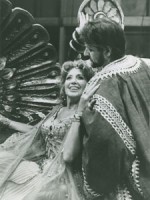Body
Few opera legends have permeated the public consciousness as thoroughly as Beverly Sills, who seemingly embraced every opportunity to share her passion. Her love of opera came through in venues as formal as the New York State Theater—the site of her breakthrough at New York City Opera—and at the Metropolitan Opera across the plaza, yet she still found time to guest host The Tonight Show and romp with the Muppets on public television.
When Sills (fondly known as “Bubbles”) died on July 2 at 78, the communal mourning was almost palpable, as if America had lost its most lauded, and most visible, classical star. Although she never studied or taught at Juilliard, her presence around campus loomed large. She had key roles in shaping New York City Opera (after her career as the company’s leading soprano she became its general director), Lincoln Center, and the Met (she served as chairwoman for both organizations), and surely many at the School experienced her warmth and vivacity.
So where does one begin with her recordings? An easy answer is Douglas Moore’s The Ballad of Baby Doe, with co-stars Walter Cassel and Frances Bible, and Emerson Buckley leading the New York City Opera Orchestra. This classic recording, reportedly made in a single take, first appeared in 1959 and was re-released in 1999 on Deutsche Grammophon. The sound, realistic and natural for the time period, captures the electricity of the moment as only great live recordings can. It is a touchstone not only of Sills’s career but also of American opera in general.
As Cleopatra in her landmark reading of Handel’s Giulio Cesare (on a 1967 RCA recording with Julius Rudel and the New York City Opera Chorus and Orchestra) Sills was now officially on the classical map, in a production that vaulted Baroque opera into the public consciousness. Today, when Gluck, Handel, Rameau, and others can be heard regularly in opera houses around the world, listeners should recall how rare productions of Baroque operas were in the mid-1960s. And if the severe cuts made in the score at that time would (rightfully) make today’s connoisseurs cringe, there is no mistaking Sills’s soaring artistry and Rudel’s eloquent accompaniment. Dedicated listeners will also seek out a live recording of highlights from the same opera conducted by Karl Richter in Buenos Aires in 1968 (released on VAI), although for some the poorer sound quality will be a compromise.
Coupled with the Handel in a one-two punch, her Manon that followed in 1970 (also on Deutsche Grammophon) only confirmed the arrival of a superstar, and many consider Sills’s version of Massenet’s masterpiece not only one of her triumphs but one of the most memorable operatic documents in the catalog. In addition to her vocal fireworks and adroit characterization, the recording (also with Rudel, this time with the New Philharmonia, in London’s All Saints Church, Tooting) shows off her partner, the great tenor Nicolai Gedda at age 45, in a touching turn as Des Grieux.
Fans hungry for more will want her effortless La Traviata (on EMI, also with Gedda and conductor Aldo Ceccato) and her dazzling Lucia di Lammermoor with Carlo Bergonzi and, in one of his few recordings, the celebrated Thomas Schippers at the helm of the London Symphony Orchestra (originally on Westminster and revived in 2002 by DGG). And of course many treasure her “Three Queens” trio of Donizetti’s Anna Bolena, Maria Stuarda, and Roberto Devereux (also DGG).
It is rare for a singer to bring a graceful, relatively early close to an extraordinary stage career, especially when her natural instrument was matched with such potent expressivity. But rather than make an endless, awkward series of farewells, Sills knew when to call it quits. The astonishing thing is how easily and naturally she transformed herself into a highly effective and tenacious advocate for the arts, bringing her gifts to bear upon the highest echelons of business and society, while retaining the down-home qualities that made her so beloved. In the end, her most memorable role may turn out to be that of Beverly Sills, cultural ambassador. Another like her is unlikely to come around any time soon.







